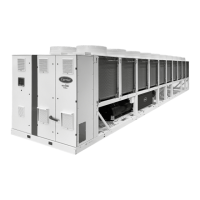10.4.3 - Precautions for connecting to the
compressor power terminals
These precautions needs to be applied whenever an operation
requires removal of the power conductors connected to the
compressor power supply terminals.
B
G
C
HD
E
F
B
Torque application to tighten the lug
C
Avoid contact between the two nuts
D
Lug tightening nut
E
Flat lug
F
Counter-nut
G
Terminal tightening nut
H
Isolator
The tightening nut on the terminal
(6)
supporting the isolator
(7)
must never be loosened, as it keeps the terminal secure and stops
the compressor leaking.
The phase lug
(4)
must be tightened applying the torque between
the counter nut
(5)
and the tightening nut
(3)
: during this operation
a counter-torque must be applied at counter nut
(5)
.
The lock nut
(5)
must not be in contact with the terminal securing
nut
(6)
.
10.5 - Condenser Coils maintenance
We recommend that coils are inspected regularly to check the
degree of cleanliness. This depends on the environment where
the unit is installed, in particular urban and industrial sites, and for
units installed near trees that shed their leaves.
Recommendations for maintenance and cleaning of micro-channel
coils (MCHE):
■ Regularly cleaning the coil surface is essential for correct unit
operation.
■ Eliminating contamination and removal of harmful residue will
increase the operating life of the coils and the unit.
■ The maintenance and cleaning procedures below are part of
the regular maintenance to increase the operating life of coils.
■ Specic recommendation in case of snow: For long term
storage, regularly check that no snow has accumulated on the
coil.
■ Clean the surface of the coil by spraying the coil regularly and
uniformly from bottom to top, orienting the water jet at right
angles to the surface. Do not exceed a water pressure of 6200
kPa (62 bar) or an angle of 45° to the coil. The nozzle must be
at least 300 mm away from the coil surface.
■ Clean and scrub the entire coil connections with a soft Nylon,
PolyPro
®
or Tynex
®
brush and low pressure tap water.
Level 1 cleaning:
■ Remove all foreign objects or fragments/debris attached to the
coil surface or wedged between the chassis and the supports.
■ Use a low-pressure dry air jet to remove all traces of dust from
the coil.
Level 2 cleaning:
■ Carry out the level 1 cleaning operations.
■ Clean the coil using suitable products.
Use appropriate PPE including safety glasses and/or mask,
waterproof clothes and safety gloves. It is recommended to
wear clothing that covers the whole body.
Specic products approved by the manufacturer for cleaning
coils are available from the manufacturer's spare parts
network. The use of any other product is strictly prohibited.
After the cleaning product is applied, rinsing with water is
mandatory.
IMPORTANT: Never use a pressure water spray without a large
diuser.
Concentrated and/or rotating water jets are strictly forbidden.
Never use a uid with a temperature above 45 °C to clean the
air heat exchangers.
Correct and frequent cleaning (approximately every three
months) will prevent 2/3 of the corrosion problems. Protect
the electrical cabinets, the motorised ball valve and the VFDs
during cleaning operations. Don't forget to remove protections
after cleaning operations.
10 - SYSTEM STANDARD MAINTENANCE
58

